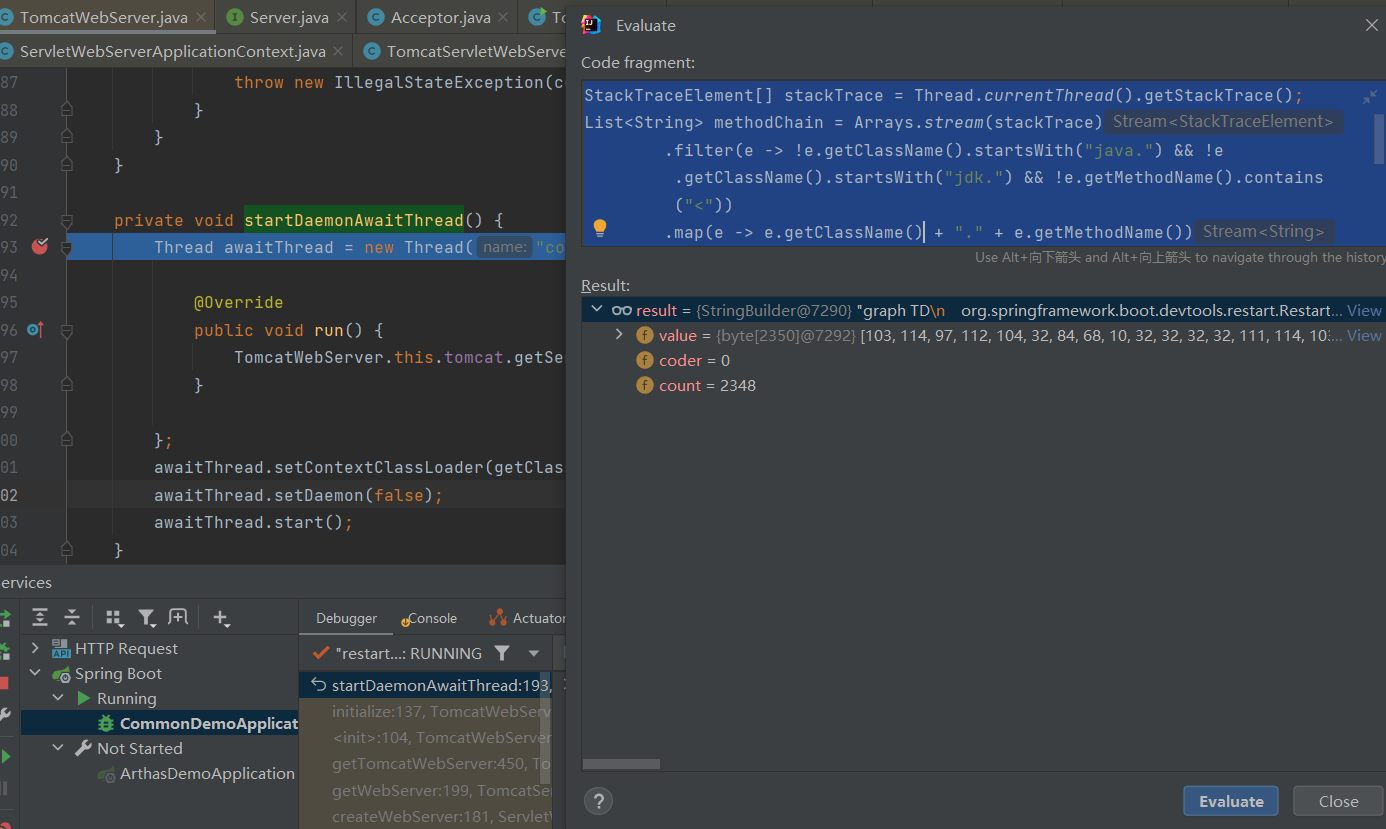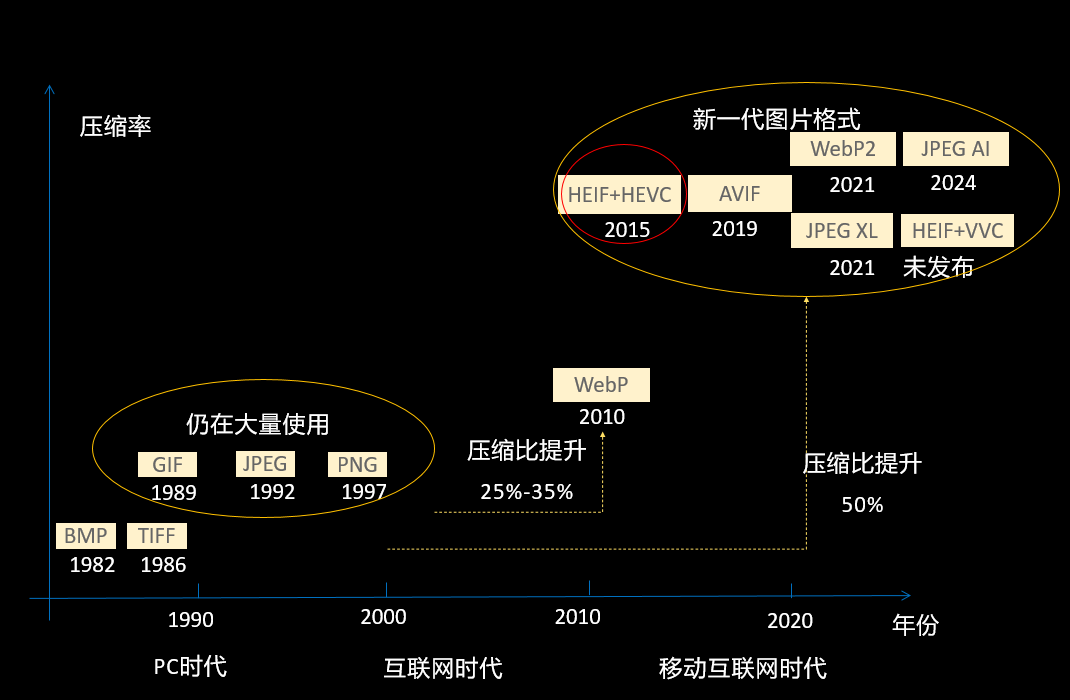前言
对于Java开发来说,天天都在用SpringBoot,每次启动都执行了main方法,该方法应该是最容易让人忽视的地方之一,不过几行代码,为什么执行完后JVM不结束呢?
本文以内嵌tomcat为例进行说明,并分享一些debug和画图的技巧。
原因
先说结论,是因为main方法启动了一个线程,这个线程是非daemon的,并且run方法执行的任务是TomcatWebServer.this.tomcat.getServer().await();(死循环),即非daemon线程+任务不停止=程序不退出。
debug源码
技巧
在debug时,有的源码是抽象方法,我们可以用快捷键F7跳转到具体正在执行的实现类方法,另外Alt+F9可以强制到达光标的位置。
流程
下面将debug对应的源码,有兴趣的朋友可以跟着动手试试。
SpringBoot启动入口,调用静态run方法。
/** 一般demo * @date 2021/9/12 9:09 * @author www.cnblogs.com/theRhyme */ @SpringBootApplication public class CommonDemoApplication { public static void main(String[] args) { SpringApplication.run(CommonDemoApplication.class, args); } } 调用重载的run方法
public static ConfigurableApplicationContext run(Class<?> primarySource, String... args) { return run(new Class<?>[] { primarySource }, args); } 创建SpringApplication对象调用run方法
public static ConfigurableApplicationContext run(Class<?>[] primarySources, String[] args) { return new SpringApplication(primarySources).run(args); } 由于该run方法很长,这里只贴到与本文main方法结束为何程序不退出的代码,对整个启动流程有兴趣的可以去看这篇:SpringBoot启动原理(基于2.3.9.RELEASE版本) 。这里我们注意refreshContext。
public ConfigurableApplicationContext run(String... args) { StopWatch stopWatch = new StopWatch(); stopWatch.start(); DefaultBootstrapContext bootstrapContext = createBootstrapContext(); ConfigurableApplicationContext context = null; configureHeadlessProperty(); SpringApplicationRunListeners listeners = getRunListeners(args); listeners.starting(bootstrapContext, this.mainApplicationClass); try { ApplicationArguments applicationArguments = new DefaultApplicationArguments(args); ConfigurableEnvironment environment = prepareEnvironment(listeners, bootstrapContext, applicationArguments); configureIgnoreBeanInfo(environment); Banner printedBanner = printBanner(environment); context = createApplicationContext(); context.setApplicationStartup(this.applicationStartup); prepareContext(bootstrapContext, context, environment, listeners, applicationArguments, printedBanner); refreshContext(context); …… refreshContext调用了一个抽象方法,我们在debug模式使用F7进入具体的实现类。
protected void refresh(ConfigurableApplicationContext applicationContext) { applicationContext.refresh(); } 这里就初始化一些资源(placeholder,beanFactory,BeanPostProcessor,MessageSource,ApplicationEventMulticaster),注意onRefresh方法。
@Override public void refresh() throws BeansException, IllegalStateException { synchronized (this.startupShutdownMonitor) { StartupStep contextRefresh = this.applicationStartup.start("spring.context.refresh"); // Prepare this context for refreshing. prepareRefresh(); // Tell the subclass to refresh the internal bean factory. ConfigurableListableBeanFactory beanFactory = obtainFreshBeanFactory(); // Prepare the bean factory for use in this context. prepareBeanFactory(beanFactory); try { // Allows post-processing of the bean factory in context subclasses. postProcessBeanFactory(beanFactory); StartupStep beanPostProcess = this.applicationStartup.start("spring.context.beans.post-process"); // Invoke factory processors registered as beans in the context. invokeBeanFactoryPostProcessors(beanFactory); // Register bean processors that intercept bean creation. registerBeanPostProcessors(beanFactory); beanPostProcess.end(); // Initialize message source for this context. initMessageSource(); // Initialize event multicaster for this context. initApplicationEventMulticaster(); // Initialize other special beans in specific context subclasses. onRefresh(); …… 进入onRefresh,这里会创建WebServer:
@Override protected void onRefresh() { super.onRefresh(); try { createWebServer(); } catch (Throwable ex) { throw new ApplicationContextException("Unable to start web server", ex); } } 这里是具体创建webServer的步骤,注意getTomcatWebServer。
@Override public WebServer getWebServer(ServletContextInitializer... initializers) { if (this.disableMBeanRegistry) { Registry.disableRegistry(); } Tomcat tomcat = new Tomcat(); File baseDir = (this.baseDirectory != null) ? this.baseDirectory : createTempDir("tomcat"); tomcat.setBaseDir(baseDir.getAbsolutePath()); Connector connector = new Connector(this.protocol); connector.setThrowOnFailure(true); tomcat.getService().addConnector(connector); customizeConnector(connector); tomcat.setConnector(connector); tomcat.getHost().setAutoDeploy(false); configureEngine(tomcat.getEngine()); for (Connector additionalConnector : this.additionalTomcatConnectors) { tomcat.getService().addConnector(additionalConnector); } prepareContext(tomcat.getHost(), initializers); return getTomcatWebServer(tomcat); } 创建TomcatWebServer对象。
protected TomcatWebServer getTomcatWebServer(Tomcat tomcat) { return new TomcatWebServer(tomcat, getPort() >= 0, getShutdown()); } 设置一些属性,并执行initialize方法。
public TomcatWebServer(Tomcat tomcat, boolean autoStart, Shutdown shutdown) { Assert.notNull(tomcat, "Tomcat Server must not be null"); this.tomcat = tomcat; this.autoStart = autoStart; this.gracefulShutdown = (shutdown == Shutdown.GRACEFUL) ? new GracefulShutdown(tomcat) : null; initialize(); } 初始化并启动tomcat容器,然后就开起非daemon await线程。
private void initialize() throws WebServerException { logger.info("Tomcat initialized with port(s): " + getPortsDescription(false)); synchronized (this.monitor) { try { addInstanceIdToEngineName(); Context context = findContext(); context.addLifecycleListener((event) -> { if (context.equals(event.getSource()) && Lifecycle.START_EVENT.equals(event.getType())) { // Remove service connectors so that protocol binding doesn't // happen when the service is started. removeServiceConnectors(); } }); // Start the server to trigger initialization listeners this.tomcat.start(); // We can re-throw failure exception directly in the main thread rethrowDeferredStartupExceptions(); try { ContextBindings.bindClassLoader(context, context.getNamingToken(), getClass().getClassLoader()); } catch (NamingException ex) { // Naming is not enabled. Continue } // Unlike Jetty, all Tomcat threads are daemon threads. We create a // blocking non-daemon to stop immediate shutdown startDaemonAwaitThread(); } catch (Exception ex) { stopSilently(); destroySilently(); throw new WebServerException("Unable to start embedded Tomcat", ex); } } } 创建非daemon线程设置线程名等参数并启动。
private void startDaemonAwaitThread() { Thread awaitThread = new Thread("container-" + (containerCounter.get())) { @Override public void run() { TomcatWebServer.this.tomcat.getServer().await(); } }; awaitThread.setContextClassLoader(getClass().getClassLoader()); awaitThread.setDaemon(false); awaitThread.start(); } 至此由于awaitThread.setDaemon(false);和TomcatWebServer.this.tomcat.getServer().await();,启动该线程awaitThread后,main方法后续虽然执行完毕,但是程序不会退出。
https://www.cnblogs.com/theRhyme/p/-/springboot-not-stop-after-main
await方法
这里单独看一下TomcatWebServer.this.tomcat.getServer().await();。
该方法的Java doc:
/** * Wait until a proper shutdown command is received, then return. * This keeps the main thread alive - the thread pool listening for http * connections is daemon threads. */
指的是通过等候关闭命令这个动作来保持main线程存活,而HTTP线程作为daemon线程会在main线程结束时终止。
任务一直运行的原因:源码如下,debug会进入getPortWithOffset()的值是-1的分支(注意这里不是server.port端口号),然后会不断循环Thread.sleep( 10000 )直到发出关机指令修改stopAwait的值为true。
@Override public void await() { // Negative values - don't wait on port - tomcat is embedded or we just don't like ports if (getPortWithOffset() == -2) { // undocumented yet - for embedding apps that are around, alive. return; } if (getPortWithOffset() == -1) { try { awaitThread = Thread.currentThread(); while(!stopAwait) { try { Thread.sleep( 10000 ); } catch( InterruptedException ex ) { // continue and check the flag } } } finally { awaitThread = null; } return; } …… stopAwait的值只会在org.apache.catalina.core.StandardServer#stopAwait中被修改,源码如下:
public void stopAwait() { stopAwait=true; Thread t = awaitThread; if (t != null) { ServerSocket s = awaitSocket; if (s != null) { awaitSocket = null; try { s.close(); } catch (IOException e) { // Ignored } } t.interrupt(); try { t.join(1000); } catch (InterruptedException e) { // Ignored } } } 而该方法会在容器生命周期结束方法org.apache.catalina.core.StandardServer#stopInternal中被调用。
非daemon线程的意义
setDaemon介绍
上面将线程设置为非daemon线程:awaitThread.setDaemon(false)。
java.lang.Thread#setDaemon源码如下:
/** * Marks this thread as either a {@linkplain #isDaemon daemon} thread * or a user thread. The Java Virtual Machine exits when the only * threads running are all daemon threads. * * <p> This method must be invoked before the thread is started. * * @param on * if {@code true}, marks this thread as a daemon thread * * @throws IllegalThreadStateException * if this thread is {@linkplain #isAlive alive} * * @throws SecurityException * if {@link #checkAccess} determines that the current * thread cannot modify this thread */ public final void setDaemon(boolean on) { checkAccess(); if (isAlive()) { throw new IllegalThreadStateException(); } daemon = on; } 根据上面的Java doc注释可知:
标记该线程是否是daemon线程,而JVM退出仅当只剩下daemon线程
。所以
非daemon线程存活,JVM是不会退出的
。例子
如下代码,我们在main方法中启动了一个非daemon线程,并且调用了阻塞方法java.io.InputStream#read()。
// https://www.cnblogs.com/theRhyme/p/-/springboot-not-stop-after-main public static void main(String[] args) { System.out.println(Thread.currentThread().getName() + ": start"); Thread awaitThread = new Thread("non-daemon") { @Override public void run() { try { System.out.println(Thread.currentThread().getName() + ": start"); System.in.read(); System.out.println(Thread.currentThread().getName() + ": end"); } catch (IOException e) { e.printStackTrace(); } } }; awaitThread.setDaemon(false); awaitThread.start(); System.out.println(Thread.currentThread().getName() + ": end"); } 启动程序后,再不进行键盘输入的情况下,程序不会停止,运行结果如下:
main: start main: end non-daemon: start main线程结束,但是程序不退出。
-1的原因
上面留了个问题,为什么getPortWithOffset()的返回值是-1。
如下getPort()的值为-1,此时相当于直接调用了getPort()方法。
https://www.cnblogs.com/theRhyme/p/-/springboot-not-stop-after-main @Override public int getPortWithOffset() { // Non-positive port values have special meanings and the offset should // not apply. int port = getPort(); if (port > 0) { return port + getPortOffset(); } else { return port; } } 而getPort直接取的是port属性。
@Override public int getPort() { return this.port; } 注意这里的port不是我们指定的server.port这个属性,而是关闭命令监听的端口。
/** * The port number on which we wait for shutdown commands. */ private int port = 8005; 为什么是8005而不是-1呢?那是在哪被修改了呢?
port属性提供的修改方式是setPort(),而使用Alt+F7找到在getServer中被修改为-1。

在server.setPort( -1 );打一个断点,重新debug,可以知道具体修改的时机。
之前我们debug过方法createWebServer,是具体创建webServer的步骤,但是我们这里要进入getWebServer。
private void createWebServer() { WebServer webServer = this.webServer; ServletContext servletContext = getServletContext(); if (webServer == null && servletContext == null) { StartupStep createWebServer = this.getApplicationStartup().start("spring.boot.webserver.create"); ServletWebServerFactory factory = getWebServerFactory(); createWebServer.tag("factory", factory.getClass().toString()); this.webServer = factory.getWebServer(getSelfInitializer()); …… 配置tomca实例参数,但是要注意这里的tomcat.getService()方法。
public WebServer getWebServer(ServletContextInitializer... initializers) { if (this.disableMBeanRegistry) { Registry.disableRegistry(); } Tomcat tomcat = new Tomcat(); File baseDir = (this.baseDirectory != null) ? this.baseDirectory : createTempDir("tomcat"); tomcat.setBaseDir(baseDir.getAbsolutePath()); Connector connector = new Connector(this.protocol); connector.setThrowOnFailure(true); tomcat.getService().addConnector(connector); customizeConnector(connector); tomcat.setConnector(connector); tomcat.getHost().setAutoDeploy(false); configureEngine(tomcat.getEngine()); for (Connector additionalConnector : this.additionalTomcatConnectors) { tomcat.getService().addConnector(additionalConnector); } prepareContext(tomcat.getHost(), initializers); return getTomcatWebServer(tomcat); } 内部调用getServer()。
public Service getService() { return getServer().findServices()[0]; } 至此,就是这里就将server.setPort( -1 );。
public Server getServer() { if (server != null) { return server; } System.setProperty("catalina.useNaming", "false"); server = new StandardServer(); initBaseDir(); // Set configuration source ConfigFileLoader.setSource(new CatalinaBaseConfigurationSource(new File(basedir), null)); // https://www.cnblogs.com/theRhyme/p/-/springboot-not-stop-after-main server.setPort( -1 ); Service service = new StandardService(); service.setName("Tomcat"); server.addService(service); return server; } 调用链
技巧
如果我们想画一个
方法本次被调用(线程内部)
的流程图,那么我们可以debug进入该方法,Alt+F8执行如下代码,打印出方法调用栈对应的mermaid js 内容,然后使用文本绘图工具进行渲染。 // https://www.cnblogs.com/theRhyme StackTraceElement[] stackTrace = Thread.currentThread().getStackTrace(); List<String> methodChain = Arrays.stream(stackTrace) .filter(e -> !e.getClassName().startsWith("java.") && !e.getClassName().startsWith("jdk.") && !e.getMethodName().contains("<")) .map(e -> e.getClassName() + "." + e.getMethodName()) .collect(Collectors.toList()); StringBuilder mermaidCode = new StringBuilder("graph TD\n"); for (int i = methodChain.size() - 1; i > 0; i--) { mermaidCode.append(String.format(" %s --> %s\n", methodChain.get(i), methodChain.get(i-1))); } System.out.println(mermaidCode); 这种方式比较适合
线程内部
展示具体方法的被调用关系,可以自定义根据包名等条件过滤掉不想要展示的类,但是对于跨线程的调用却不起作用,因为原理是线程自身的调用栈。具体内容
如图,debug到org.springframework.boot.web.embedded.tomcat.TomcatWebServer#startDaemonAwaitThread内部,执行上面的代码。

输出内容:
graph TD org.springframework.boot.devtools.restart.RestartLauncher.run --> cnblogscomtheRhyme.infrastructure.demos.common.CommonDemoApplication.main cnblogscomtheRhyme.infrastructure.demos.common.CommonDemoApplication.main --> org.springframework.boot.SpringApplication.run org.springframework.boot.SpringApplication.run --> org.springframework.boot.SpringApplication.run org.springframework.boot.SpringApplication.run --> org.springframework.boot.SpringApplication.run org.springframework.boot.SpringApplication.run --> org.springframework.boot.SpringApplication.refreshContext org.springframework.boot.SpringApplication.refreshContext --> org.springframework.boot.SpringApplication.refresh org.springframework.boot.SpringApplication.refresh --> org.springframework.boot.SpringApplication.refresh org.springframework.boot.SpringApplication.refresh --> org.springframework.boot.web.servlet.context.ServletWebServerApplicationContext.refresh org.springframework.boot.web.servlet.context.ServletWebServerApplicationContext.refresh --> org.springframework.context.support.AbstractApplicationContext.refresh org.springframework.context.support.AbstractApplicationContext.refresh --> org.springframework.boot.web.servlet.context.ServletWebServerApplicationContext.onRefresh org.springframework.boot.web.servlet.context.ServletWebServerApplicationContext.onRefresh --> org.springframework.boot.web.servlet.context.ServletWebServerApplicationContext.createWebServer org.springframework.boot.web.servlet.context.ServletWebServerApplicationContext.createWebServer --> org.springframework.boot.web.embedded.tomcat.TomcatServletWebServerFactory.getWebServer org.springframework.boot.web.embedded.tomcat.TomcatServletWebServerFactory.getWebServer --> org.springframework.boot.web.embedded.tomcat.TomcatServletWebServerFactory.getTomcatWebServer org.springframework.boot.web.embedded.tomcat.TomcatServletWebServerFactory.getTomcatWebServer --> org.springframework.boot.web.embedded.tomcat.TomcatWebServer.initialize org.springframework.boot.web.embedded.tomcat.TomcatWebServer.initialize --> org.springframework.boot.web.embedded.tomcat.TomcatWebServer.startDaemonAwaitThread org.springframework.boot.web.embedded.tomcat.TomcatWebServer.startDaemonAwaitThread --> idea.debugger.rt.GeneratedEvaluationClass.invoke 把内容放入文本绘图中,即可得到如下流程图:






















这一切,似未曾拥有